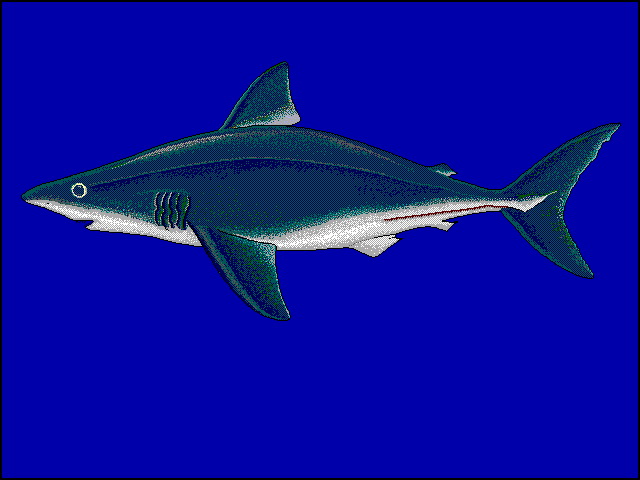|
| Query: Salmon herring | Result: 11th of 15 | |
Porbeagle Shark (Lamna nasus) - Wiki
| Subject: | Porbeagle Shark (Lamna nasus) - Wiki
| |

| Resolution: 640x480
File Size: 61554 Bytes
Date: 2007:09:17 11:23:47
Upload Date: 2007:09:17 11:27:16
|
Porbeagle
From Wikipedia, the free encyclopedia
[Photo] Porbeagle Shark (Lamna nasus). Source: http://www.fishbase.org Drawing by former FishBase staff member Robbie N. Cada.
The porbeagle, Lamna nasus, is a large pelagic predatory shark of the family Lamnidae. The porbeagle is considered vulnerable to extinction, and the European Union has proposed listing the porbeagle under the United Nations Convention on International Trade in Endangered Species (CITES).
Naming
The origins of the name porbeagle are unknown. The Oxford English Dictionary attributes its first appearance to a Cornish dialect. It is possible it is derived from two old French words meaning hog and nose. The Greek lamna means shark and nasus means nose.
Distribution
The porbeagle's distribution ranges from the northeastern coast of North America, from New Jersey to Greenland and from the northwestern coast of Africa, Morocco or Western Sahara and the Mediterranean, and up to the waters off Iceland to the north coast of Norway and the northwestern coast of Russia. In the southern hemisphere its distribution is circumglobal from 30° to 60° south.
The porbeagle is listed as "Vulnerable" on the IUCN (World Conservation Union) Red List of Threatened Species. Canada also lists the porbeagle as an endangered species and overfishing has recently decimated numbers in British waters.
Habitat
The porbeagle is mainly a pelagic shark, but can be found in coastal waters. It lives in cold water commonly from about 5°C to 10°C (41°F to 50°F), but have been found down to 1°C (33°F) and up to 23°C (71°F). It can be found at the surface and to a depth of more than 700 metres.
Anatomy and appearance
The most distinguishing characteristic of the porbeagle is a white patch on the trailing edge of the dorsal fin. This distinguishes it from both the salmon shark and the great white shark. It has two keels on the caudal fin, in common with the salmon shark.
The porbeagle is a stout and heavy shark, dark blue-grey on top and white underneath, with a conical snout. The porbeagle can grow to about 3.7 m (12 ft), weighing about 160 to 250 kg (350 to 550 lb).
Behaviour
The porbeagle is among the fastest sharks. It can jump fully out of the water, a behavior observed in only a few sharks.
Diet
The porbeagle is an opportunistic feeder, it eats mostly bony fish like mackerel, herring, lancetfish and sauries.
Reproduction
The porbeagle is ovoviviparous. Gestation period is about 8 to 9 months. Litters of up to 6 pups have been recorded but the normal size is about 4. Pups are about 60 to 80 cm long when born. Female porbeagles reaches sexual maturity at about 12 to 13 years and males at 7 to 8 years.
http://en.wikipedia.org/wiki/Porbeagle
| The text in this page is based on the copyrighted Wikipedia article shown in above URL. It is used under the GNU Free Documentation License. You may redistribute it, verbatim or modified, providing that you comply with the terms of the GFDL. |
|
Comments |
|---|
| | Guest |
|
Scientific Name: Lamna nasus (Bonnaterre, 1788)
Common Names:
English – Porbeagle
Spanish – Marrajo Sardinero, Tiburón Sardinero, Tintorera
French – Requin-taupe Commun |
| | Guest |
|
Scientific Name: Lamna nasus (Bonnaterre, 1788)
Common Names: Porbeagle, Porbeagle Shark; [French] Requin-taupe Commun, Maraîche; [Spanish] Marrajo Sardinero, Tiburón Sardinero, Tintorera
Synonyms:
Lamna whitleyi Phillipps, 1935
Lamna cornubicus (Gmelin, 1789)
Squalus monensis Shaw, 1804
Squalus nasus Bonnaterre, 1788 |
^o^
Animal Pictures Archive for smart phones
^o^
|
|
|

